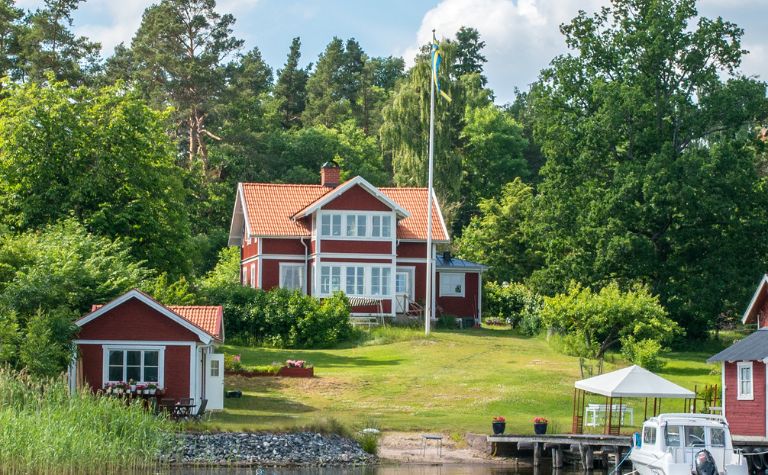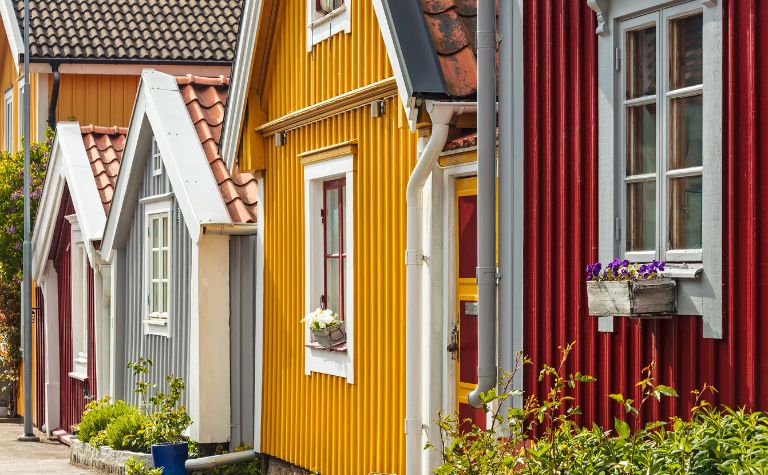The standard of living in Sweden is high, especially compared to other countries, even European countries. [1]
The quality of life is particularly high in the country as people can enjoy several benefits, including high incomes. However, this quality comes at a price.
The cost of living in Sweden for one person is $1398 without rent.
With rent, the cost can go up dramatically, with expenses going up to $3107 depending on where the person lives.
These rates mean that the cost of living in Sweden is one and a half times more expensive than in the rest of the world.
The cost of living is affected by the high labor costs, high taxation rates used for free healthcare and education for the citizens, and high rentals. [2]
While utility expenses are fairly reasonable, the actual cost of renting houses is prohibitive, especially in Stockholm.
Also, see How to Move to Sweden to learn more.

What Is the Average Rent in Sweden?
Renting in Sweden is difficult, with the market being particularly competitive and expensive. Municipalities have their renting agencies, and people who want to rent directly from landlords are often on waiting lists for several years. [3]
The average rent in Sweden is between $1050 to $1400 for a one-bedroom apartment, depending on the city.
Stockholm is more expensive, but living in the city suburbs is cheaper than living in the city center. Cities like Uppsala and Gothenburg have slightly lower rents than Stockholm.
One-bedroom apartments in the suburbs of Stockholm cost about $965, and these areas tend to be cheaper overall than living in the city’s heart. [4]
Public transportation is extensive in the country, so living in the suburbs is perfectly acceptable for most people. [5]
On average, the cost of rent increases by 1% every year in Sweden, and most people resort to second-hand rentals, a term used for subletting in Sweden.
Subletting tends to be even more expensive than regular rentals but is often the only option when waiting lists for first-hand rentals span several years.
Second-hand rentals are easier to find than first-hand but are usually only available for limited periods. Typically, second-hand rental contracts are for no longer than a year.
Notice periods for rentals tend to be about a month.
The Swedish government has attempted to address the rising rental rates by setting caps on rent every year, which prevents the rates from increasing by more than 2%. [6]
Over time, the industry has also expanded, and the number of municipalities reporting a housing shortage has decreased slowly.
Nevertheless, rent remains one of the largest expenses of any resident in Sweden, especially those who live in Stockholm.
Most residents find that nearly 30% of their incomes are used up in rent. [7]
Also, see What Is Sweden Known For? to learn more.

What Is the Average Price of a House in Sweden?
Considering the persistence of the housing crisis, buying is usually the best option for Swedish residents.
Immigrants, young people, and anyone new to the housing market are usually better off buying a property rather than renting, partly due to the exorbitant rents.
However, purchasing a home is also increasingly expensive, which makes the living situation particularly tough. [8]
The average price of a house in Sweden can range from 1,603,000 SEK to 6,038,000 SEK ($148,747 to $560,286 USD), depending on the country. [9]
The process of purchase is fairly fast, and the lower interest rates contribute to the purchase being a good investment in the long run.
Since the financial crisis in 2008, the rates of property have increased sharply, with an almost 50% increase in rates in ten years. [10]
The price increases have slowed in recent times, but the limited number of properties being built keeps the property in a seller’s market.
Finding a house to buy remains the greatest challenge, even for foreigners. There are no restrictions on foreigners buying property in Sweden.
However, the scarcity of available houses means that most buyers find themselves in bidding wars to secure a property purchase.
People who wish to purchase houses in Sweden are advised to work with a real estate agent whenever possible to make the purchase as easy as possible.
If you will need a mortgage to purchase your property, you will need to produce the following documents:
- Proof of employment and income
- Swedish ID card
- Residence permit
- Credit history
- Personal Identity Number or the personnummer
Up to 30% of the mortgage amount is tax deductible, which works out well for buyers in the long run.
However, with the fixed mortgage rates increasing, purchasing houses in Sweden is slowly becoming more and more expensive.
Also, see Is Sweden Socialist? to learn more.

Does Sweden Have Free Healthcare?
While taxation rates in Sweden are fairly high, residents and citizens are happy to pay the taxes as the money is used for their benefit.
The country has a highly rated healthcare system that is decentralized and follows the Nordic model. [11]
Sweden has mostly free healthcare, where the public universal healthcare system covers patient fees for children and the elderly and regular screenings.
Prescriptions tend to have a co-pay fee, but most medication is subsidized.
The Swedish healthcare system is decentralized, so local authorities and municipalities are typically responsible for determining what they can spend on healthcare.
Due to this decentralization, the degree to which healthcare is subsidized will vary from region to region.
Sweden has both public and private healthcare, so people who choose private services tend to pay full price for their doctor’s visits and medication.
Many services are free or subsidized by taxes under public healthcare, including dental services, which are free until people reach the age of 23. [12]
Visitors to Sweden may have to pay full price for medication. However, if they’re from Switzerland or EU/EEA countries, they may need to pay only as much as residents insured by Swedish healthcare.
Visitors from countries like Australia, Algeria, Israel, and Turkey, among others, can receive specific healthcare in Sweden. [13]
The treatments they can receive depend on the terms of Sweden’s medical care agreement with their country of origin.
Conclusion
Although taxes cover healthcare, the cost of living in Sweden is high due to the high rental rates in the country.
Also, see Why Is Sweden So Rich? to learn more.
References:
[1] Source
[2] Source
[3] Source
[4] Source
[5] Source
[6] Source
[7] Source
[8] Source
[9] Source
[10] Source
[11] Source
[12] Source
[13] Source
